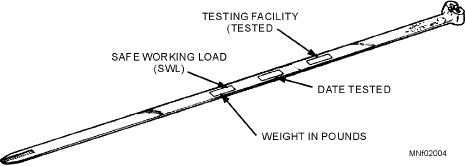
Except as otherwise indicated, portable
Multiple-leg, wire-rope slings are shackled or
safety-hooked to lugs, rings, eyebolts, or lifting eyes.
ordnance-handling equipment used ashore must be
They are either an integral part of the load or are
tested annually at 40 percent of the design load of the
attached temporarily during handling.
equipment. This testing schedule must be followed for
all ordnance-lifting equipment, unless specifically
Before you use any ordnance-handling equipment,
exempted by higher authority.
you should verify that it has been tested and that the test
date is current. Inspect the equipment for evidence of
Equipment that has satisfactorily passed the
wear, such as frayed threads, broken stitches, cuts,
periodic load test requirements must have the name of
damaged cables, loose fasteners, missing safety
the testing facility, the date tested, and the safe working
keepers, bent hooks, and so forth. If any such damage is
load (SWL) stenciled in legible, contrasting colored
noted, remove the equipment from service.
paint on a conspicuous surface, or this information
may be stamped or etched on a tag that is securely
MK 95 MOD 0 TORPEDO SLING.--Although
its nomenclature indicates it is used with torpedoes,
attached to the equipment. See figure 2-4. New
this sling is also used with other cylindrically shaped
ordnance-handling equipment, received in original
weapons that are 21 inches in diameter and within its
packaging if an inspection shows that the equipment is
rated lifting capacity of 5,000 pounds. Fabricated of
free of defects, may have the test date changed to the
nylon webbing with a loop that is reinforced with a
current date without retest. A record of each periodic
leather pad at each end, the sling is used for loading the
test must be maintained by the facility performing the
Mk 67 mine aboard submarines. As shown in figure
periodic test.
2-5, the sling is wound twice around the mine with one
For further information regarding the testing of
loop inserted through the other to form a double-wrap
ordnance-handling equipment, refer to Periodic
choker hitch. The loops are reinforced with leather
Te s t i n g A r ra n ge m e n t s f o r O rd n a n c e H a n d l i n g
wear pads, and both sides of the body have nylon wear
Equipment, NAVSEA SG420-AP-MMA-010.
straps so that either side may bear directly against the
mine without chafing.
Lifting equipment, used for handling ammunition
and explosives, specifically mines, includes adapters,
MK 99 MOD 0 WEAPONS-HANDLING
booms, hoists, lifting attachments, and slings. The
SLING.--The Mk 99 Mod 0 weapons-handling sling
following subsections discuss various types of
is used at dockside and aboard ammunition ships for
handling equipment and their uses.
loading combatant ships with crated mines and
palletized unit loads of mines. This sling, as shown in
Slings
figure 2-6, consists of four swiveled safety hooks, each
attached to a flexible, galvanized 1/2-inch, wire-rope
In the assembly areas, slings are used mainly for
leg. The four legs are joined to a 5 1/2-inch lifting ring
crating, uncrating, and marrying various sections of
that is compatible with standard cargo lifting gear used
the mines. They are used for shipboard loading and
at dockside or aboard ammunition ships. Its rated
off-loading of mines at dockside and for transferring
lifting capacity is 6,000 pounds. The sling is used for
the mines between ships at sea. Slings can be classified
lifting one crated Mk 56 mine.
into the following two groups:
MK 101 MOD 0 MINE SLING.--Except for its
Nonmetallic nylon slings form a choker hitch
shorter length, the Mk 101 Mod 0 mine sling, as shown
around the body of the mine or the mine component.
in figure 2-7, is similar to the Mk 95 Mod 0 torpedo
Figure 2-4.--Weight test inspection tag.
2-15

